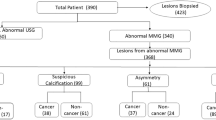Abstract
Background
To retrospectively compare the diagnostic accuracy of digital breast tomosynthesis (DBT), digital mammography (DM), and ultrasonography (US) in non-calcified ductal carcinoma in situ (DCIS, include DCIS with micro-invasion).
Patients and methods
Ninety-eight patients with non-calcified DCIS (include DCIS with micro-invasion) were enrolled in our study. Breast carcinoma in situ was confirmed by surgical pathologic evaluation. Our Institutional Review Board granted approval and the participating women provided written informed consent. The imaging findings were evaluated according to the Breast Imaging Reporting and Data System (BI-RADS) of the American College of Radiology (ACR) by comparing the differences in the detection rate and diagnostic accuracy among the three techniques in all cases, in dense breasts, and in non-dense breasts.
Results
The detection rates of DBT, DM, and US for non-calcified DCIS in all cases were 83.7, 68.4, and 94.9%, respectively, and in patients with dense breasts were 81.2, 63.8, and 95.0%. The detection rate of US was higher than DBT, which, in turn, was higher than DM both in all cases and in dense breasts. Pairwise comparisons among the three techniques showed that the differences were statistically significant (P = 0.000 and P = 0.000, respectively). The experts identified a case as abnormal for all criteria (BI-RADS score of 4B-5) in 68.4% of ratings using DBT, 43.9% of ratings using DM, and 66.3% of ratings using US; for dense breasts, the positive identification rates were 62.5% of ratings using DBT, 41.2% of ratings using DM, and 61.2% of ratings using US. The diagnostic accuracy of DBT and US was significantly higher than that of DM in all cases (P = 0.001 and P = 0.006, respectively) and in dense breasts (P = 0.007 and P = 0.011, respectively). The diagnostic accuracy of DBT was slightly higher than US in all cases and in dense breasts, but the difference was not statistically significant (P = 0.761 and P = 0.871, respectively). By DBT, most non-calcified cases of DCIS presented as a mass lesion (54.9%) with an irregular shape (46.7%), indistinct margin (53.3%), and isodense composition (71.1%). Using US, 72 of 93 patients (77.4%) were shown to have a mass. Most mass lesions had an irregular shape (83.3%), indistinct margin (55.5%), and parallel the skin (82.8%).
Conclusion
DBT and US gave better detection rates and diagnostic accuracy for non-calcified DCIS compared with DM in all cases and in dense breasts. The detection rate of DBT was lower than that of US in all cases and in dense breasts. The diagnostic accuracy of DBT was slightly higher than that of US in all cases and in dense breasts, but the difference was not statistically significant. Imaging findings for non-calcified DCIS were relatively non-specific.




Similar content being viewed by others
References
Silverstein MJ. Ductal carcinoma in situ of the breast. BMJ. 1999;319:557.
Stomper PC, Connolly JL, Meyer JE, Harris JR. Clinically occult ductal carcinoma in situ detected with mammography: analysis of 100 cases with radiologic pathologic correlation. Radiology. 1989;172:235–41.
Noroozian M, Hadjiiski L, Rahnama-Moghadam S, Klein KA, Jeffries DO, Pinsky RW, et al. Digital breast tomosynthesis is comparable to mammographic spot views for mass characterization. Radiology. 2012;262:61–8.
Rafferty E, Jeong MI, Liane E, et al. Assessing radiologist performance using combined digital mammography and breast tomosynthesis compared with digital mammography alone: results of a multicenter, multireader trial. Radiology. 2013;266:104–13.
Dershaw DD, Abramson A, Kinne DW. Ductal carcinoma in situ: mammographic findings and clinical implications. Radiology. 1989;170:411–5.
Ikeda DM, Andersson I. Ductal carcinoma in situ: atypical mammographic appearances. Radiology. 1989;172:661–6.
Cserni G, Wells CA, Kaya H, et al. Consistency in recognizing microinvasion in breast carcinomas is improved by immunohistochemistry for myoepithelial markers. Virchows Archiv. 2016;468:473–81 (Springer).
Andersson I, Ikeda DM, Zackrisson S, et al. Breast tomosynthesis and digital mammography: a comparison of breast cancer visibility and BIRADS classification in a population of cancers with subtle mammographic findings. Eur Radiol. 2008;18:2817–25.
Skaane P, Bandos AI, Gullien R, et al. Comparison of digital mammography alone and digital mammography plus tomosynthesis in a population-based screening program. Radiology. 2013;267:47–56.
Niklason LT, Christian BT, Niklason LE, et al. Digital tomosynthesis in breast imaging. Radiology. 1997;205:399–406.
Lee CI, Cevik M, Alagoz O, et al. Comparative effectiveness of combined digital mammography and tomosynthesis screening for women with dense breasts. Radiology. 2015;274:772–80.
Vercauteren LD, Kessels AG, van der Weijden T, Koster D, Severens JL, van Engelshoven JM, et al. Clinical impact of the use of additional ultrasonography in diagnostic breast imaging. Eur Radiol. 2008;18:2076–84.
Helvie MA. Digital mammography imaging: breast tomosynthesis and advanced applications. Radiol Clin NA. 2010;48:917–29.
Moon WK, Myung JS, Lee YJ, et al. US of ductal carcinoma in situ. Radiographics. 2002;22:269.
Author information
Authors and Affiliations
Corresponding author
Ethics declarations
Conflict of interest
The authors declare that they have no conflict of interest.
About this article
Cite this article
Su, X., Lin, Q., Cui, C. et al. Non-calcified ductal carcinoma in situ of the breast: comparison of diagnostic accuracy of digital breast tomosynthesis, digital mammography, and ultrasonography. Breast Cancer 24, 562–570 (2017). https://doi.org/10.1007/s12282-016-0739-7
Received:
Accepted:
Published:
Issue Date:
DOI: https://doi.org/10.1007/s12282-016-0739-7




